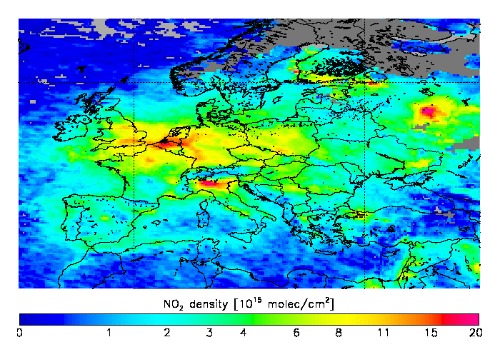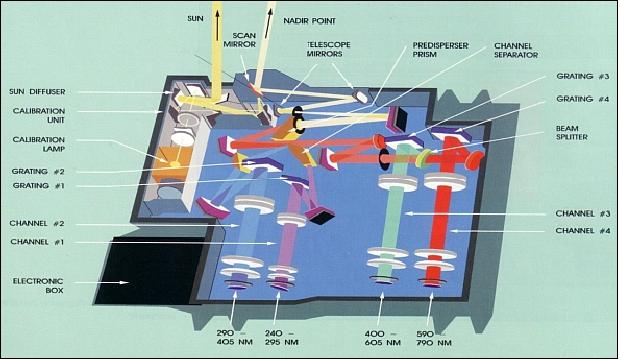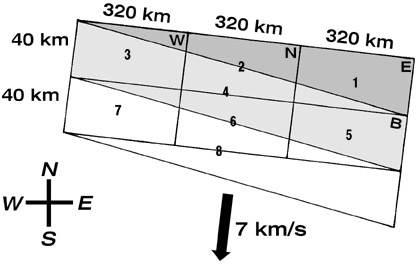GOME Overview
Applications

Global Ozone Monitoring Experiment (GOME) was a nadir-scanning ultraviolet and visible spectrometer for global monitoring of atmospheric ozone. ESA delivered three-day GOME global observations of total ozone, nitrogen dioxide and related cloud information. A key feature of GOME was its ability to detect other chemically active atmospheric trace-gases as well as aerosol distribution. The main objective of GOME was to observe upwelling solar radiation reflected or scattered in Earth's atmosphere and from its surface. The measured spectrum contains absorption features which can be used to derive quantitative information on the presence of ozone, and of a number of other atmospheric chemicals. In addition to the improved backscattering technique, GOME exploited the full capabilities of the enhanced ATSR instrument on board ERS-2. The GOME measurement concept is based on 'Differential Optical Absorption Spectroscopy' (DOAS), a technology proven in balloon flights.
Other GOME objectives included measurement of total column amounts and stratospheric and tropospheric profiles of ozone on a daily basis, measurement of column amounts of H2O and other gases involved in ozone photochemistry (like NO2, OClO, BrO, and possibly ClO in anticyclonic conditions, and pollutants like SO2 and HClO). GOME could also be used to investigate the distribution of atmospheric aerosols and clouds-plus-surface spectral reflectance. In addition to the default measurement mode, GOME operations included the following specific measurement modes:
- Narrow Swath
- North Polar View
- South Polar View
- Monthly/Quarterly Calibration
- Daily Calibration (solar calibration)
The operational products retrieved from GOME measurements are ozone and nitrogen dioxide total columns as well as cloud information.
Design

GOME was a nadir viewing spectrometer with an across-track scan sequence consisting of four ground pixel types called East, Nadir, West, and Backscan with 1.5 second integration time each (default mode). The three forward-scan pixels had nominal resolution of 40 km x 320 km while the back-scan pixel had a resolution of 40 km x 960 km. The default mode with the largest footprint provided global coverage at the Equator within three days. Measurements for both forward- and back-scan pixels were processed and written to the products.
The spectrometer split the incoming light into its spectral components in the UV/VIS region from 240 nm to 790 nm at a resolution from 0.2 nm (UV, Channel 1) to 0.4 nm (VIS, channel 4). The operational products retrieved from GOME measurements are ozone and nitrogen dioxide total columns as well as cloud information.
Raw ozone data is stored on board ERS-2 and then, together with other raw data, transmitted to Earth as the spacecraft passes over one of the four ERS ground stations in Europe and Canada. From there they are either transmitted directly via satellite to the GOME data centre at Oberpfaffenhofen near Munich. In developing the ground segment ESA has at each stage been advised by an international committee made up of eminent atmospheric researchers from Germany, France, Italy, Great Britain, Belgium, the Netherlands and the USA.
The GOME data centre, housed on the premises of the German remote-sensing data service, catalogues and archives all incoming data and at the same time extracts from the spectra the most important information contained in them, namely the total ozone content of the atmosphere in the form of a world ozone map. Every measurement represents the ozone content of a column of air over a rectangle on Earth's surface, the size of the rectangles varying from 40x40 to 40x320 kilometres depending on the desired temporal and spatial resolution.
Other institutes in Europe and the United States have planned to combine raw data and ozone values from GOME with information from other sources to produce more useful products. Examples are the production of regular ozone maps, ozone depletion prediction or the acquisition of information concerning aerosols, sulphur dioxide and nitrogen oxide in the atmosphere.
Although evaluation of GOME raw data is carried out under the overall responsibility of ESA, which also bears part of the costs, the analysis itself is mainly performed by the institutes and the 50 or so principal investigators who use ozone data in their daily work.
- Spatial Resolution: Vertical: 5km (for O3), Horizontal: 40 x 40 km to 40 x 320 km
- Swath Width: 120-960km
- Waveband: UV-NIR: 240 - 790 nm (resolution 0.2-0.4nm)
Sensor Modes

GOME was a nadir viewing spectrometer with an across-track scan sequence consisting of four ground pixel types called East, Nadir, West, and Backscan with 1.5 sec integration time each (default mode). The three forward-scan pixels had nominal resolution of 40 km x 320 km while the back-scan pixel 40 km x 960 km. The default mode with the largest footprint provided global coverage at the Equator within three days. Measurements for both forward- and back-scan pixels were processed and written to the products.
Details can be found in the GOME User Manual.
Mission Operations
The ERS-2 mission GOME instrument was operational for about 16 years, from April 1995 until September 2011. A detailed review of the most important events over the mission lifetime, impacting the quality of the GOME data, is presented in this GOME mission operations overview.
GOME Resources
- Readme file for GOME Level 2 version 5 products
- Upgrade of the GOME Data Processor for Improved Total Ozone Columns
- GOME Product User Manual
- GOME GDP 5 Validation Report
- Access to ESA Earth Observation Data - Quick Guide
- Product Specification Document of the GOME Data Processor
- GOME Data Processor Extraction Software User's Manual
- GOME Data Product Improvement Validation Report
- GOME Users Manual